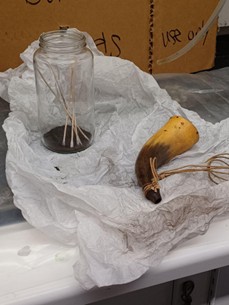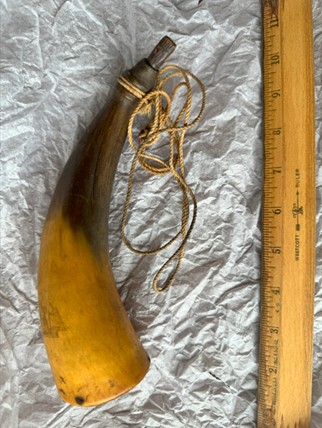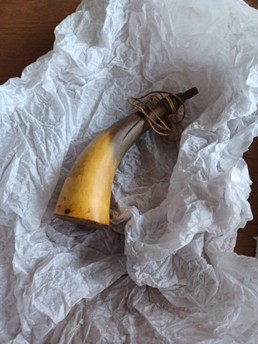In this post, Special Collections staff member Alyssa Bonaro shares an account of a unique internship experience.
During Spring 2025, I was completing my Master’s in Library and Information Science (MLIS) while working at Silver Special Collections. For my program’s final project, I did an internship at the Library Research Annex (LRA). This experience led to an exciting discovery.
Under the guidance of archivist Erin Doyle, I processed manuscript collections, including the Harlan Paige Papers. Harlan Paige was a Civil War veteran from Vermont and the papers document his life and Paige family genealogy. The collection contains a variety of materials–Civil War era letters, correspondence between family members about genealogy, photographs, a handmade dress, and a number of objects.
One of those objects was a brown horn-shaped item wrapped in white tissue paper. It was tucked inside a small box on a shelf in the Special Collections processing room in Billings. Some research suggested that the item was likely a powder horn, a container used to carry gunpowder. Upon my initial inspection, there wasn’t anything about the object that made me think gunpowder could still be inside.
However, after the horn was sent from Billings to the LRA, I opened the box to find that the previously clean tissue paper now had gray smudges. A small amount of dark powder was nestled into the paper’s creases. There was also a distinctive smell. It seemed that the powder horn did still contain gunpowder.
I told Erin about the discovery, and she reached out to our colleague Erica Donnis, who is president of the Collections Care and Conservation Alliance. Erica contacted the armorer at West Point for guidance on identifying whether the horn and powder were authentic. They told us that the horn likely dated back to the Revolutionary War. Since most horns in that period were made from the horn of an ox, ours likely was too. We do not know how the horn ended up in Harlan and/or his family’s possession.
For the gunpowder, the West Point armorer recommended a water solubility test to determine if the powder would smear when exposed to water. If so, then the powder was likely real. Erica performed the test and found that the powder did smear.
Since we had confirmation that the horn likely contained actual gunpowder, we needed to dispose of it safely. Erica reached out to UVM Environmental Services and scheduled a time for us to meet with them to remove the powder.
The most exciting part of this discovery was watching UVM Environmental Services carry out the removal. They were able to pour the majority of the powder from the horn, although a lead shot stuck inside prevented complete removal. We took photos of the process.

The final results. The Environmental Services technician used cotton swabs to help remove the powder, which he deposited in the glass jar.
To learn more about Paige and the collection, visit the Harlan Paige Papers finding aid.



